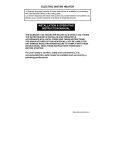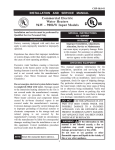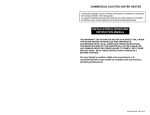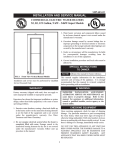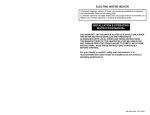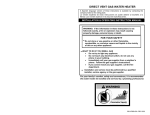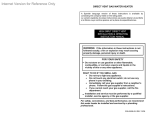Download Bock Water heaters operation Instruction manual
Transcript
COMMERCIAL ELECTRIC WATER HEATER La estas of instrucciones se puede obtener al a A version Spanishespanola languagede version these instructions is available byescribirle contacting lathe fábrica cuyo listed nombre la placa de especificaciones. company on aparece the ratinginplate. ALa Spanish of instrucciones these instructions is available byalcontacting versiónlanguage espãnolaversion de estas se puede obtener escribirle the on aparece the ratingenplate. a lamanufacturer fábrica cuyolisted nombre la placa de especificaciones. INSTALLATION & OPERATING INSTRUCTION MANUAL THE WARRANTY ON THIS WATER HEATER IS IN EFFECT ONLY WHEN THE WATER HEATER IS INSTALLED AND OPERATED IN ACCORDANCE WITH LOCAL CODES AND THESE INSTRUCTIONS. THE MANUFACTURER OF THIS HEATER WILL NOT BE LIABLE FOR ANY DAMAGE RESULTING FROM FAILURE TO COMPLY WITH THESE INSTRUCTIONS. READ THESE INSTRUCTIONS THOROUGHLY BEFORE STARTING. For your family’s comfort, safety and convenience, it is recommended this water heater be installed and serviced by a plumbing professional. 238-16152-00K REV 05/07 TABLE OF CONTENTS General Information .......................................................... 3 Installation ......................................................................... 4 Locating The Water Heater.................................................... Water Connections ................................................................ Electrical Connections .......................................................... Amperage Chart ..................................................................... GPH Recovery Capacities ..................................................... General Operation ............................................................. Thermostat Adjustment......................................................... Maintenance....................................................................... Notes .................................................................................. 4 6 11 12 12 13 14 16 19 CONGRATULATIONS! You have just purchased one of the finest water heaters on the market today! This installation, operation and instruction manual will explain in detail the installation and maintenance of your new Commercial Electric Water Heater. The Manufacturer strongly recommend that you contact a plumbing professional for the installation of this water heater. We require that you carefully read this manual, as well as the enclosed warranty, and refer to it when questions arise. If you have any specific questions concerning your warranty, please consult the plumbing professional from whom your water heater was purchased. For your records we recommend that you write the model, serial number and installation date of your water heater in the maintenance section in the back of this manual. This manual should be kept with the water heater. 2 GENERAL INFORMATION The design of this electric water has been listed with Underwriters’ Laboratories, Inc. (UL) as complying with UL standard UL1453. This water heater must be installed in accordance with local codes. In the absence of local codes, install this water heater in accordance with the N.E.C. Reference Book (latest edition). The warranty for this water heater is in effect only when the water heater is installed, adjusted and operated in accordance with these Installation and Operating Instructions. The manufacturer will not be held liable for damage resulting from alteration and/or failure to comply with these instructions. This water heater has been designed and listed for the purpose of heating potable water. The installation and use of this water heater for any purpose other than the heating of potable water may cause damage to the water heater and create a hazardous condition and nullify the warranty. CAUTION Incorrect operation of this appliance may create a hazard to life and property and will nullify the water. Do not use this appliance if any part has been under water. Immediately call a qualified service technician to inspect the appliance and to replace any part of the control system and/or any gas control, which has been under water. Depending upon individual circumstances, it may be necessary to replace the entire water heater. Make sure that the rating plate on the water heater is referenced for certainty that the correct voltage is being supplied to the water heater. DANGER Do not store or use gasoline or other flammable, combustible or corrosive vapors and liquids in the vicinity of this or any other appliance. 3 General Information continued- A sacrificial anode(s) is used to extend tank life. Removal of any anode, for any reason, will nullify the warranty. In areas where water is unusually active, an odor may occur at the hot water faucet due to a reaction between the sacrificial anode and impurities in the water. If this should happen, an alternative anode(s) may be purchased from the supplier that installed this water heater. This will minimize the odor while protecting the tank. Additionally, the water heater should be flushed with appropriate dissolvers to eliminate any bacteria. IMPORTANT Before proceeding, please inspect the water heater and its components for possible damage. DO NOT install any damaged components. If damage is evident, please contact the supplier where the water heater was purchased or the manufacturer listed on the rating plate for replacement parts. INSTALLATION Locating The Water Heater WARNING Water heaters are heat-producing appliances. To avoid damage or injury, there must be no materials stored against the water heater and proper care must be taken to avoid unnecessary contact (especially by children) with the water heater. UNDER NO CIRCUMSTANCES SHALL FLAMMABLE MATERIALS, SUCH AS GASOLINE OR PAINT THINNER BE USED OR STORED IN THE VICINITY OF THIS WATER HEATER OR ANY LOCATION FROM WHICH FUMES COULD REACH THE WATER HEATER. This water heater MUST be installed indoors out of the wind and weather. This water heater must NOT be installed in any location where gasoline or flammable vapors are likely to be present, unless the installation is such to eliminate the ignition of gasoline or flammable vapors. The location for the installation of this water heater is of utmost importance. Before installing this water heater, consult the installation section of these instructions. After reading these installation and operating instructions, select a location for the water heater where the floor is level and is easily accessible to a power supply and water connections. 4 Locating The Water Heater continued- It is recommended that the water heater be located near the center of greatest hot water usage to prevent heat loss through the pipes. DO NOT locate the water heater where water lines could be subjected to freezing temperatures. Locate the water heater so that access panels and drain valves are accessible. Water heater corrosion and component failure can be caused by the heating and breakdown of airborne chemical vapors. Examples of some typical compounds that are potentially corrosive are: spray can propellants, cleaning solvents, refrigerator and air conditioning refrigerants, swimming pool chemicals, calcium or sodium chloride, waxes and process chemicals. These materials are corrosive at very low concentration levels with little or no odor to reveal their presence. NOTE: DAMAGE TO THE WATER HEATER CAUSED BY EXPOSURE TO CORROSIVE VAPORS IS NOT COVERED BY THE WARRANTY. DO NOT OPERATE THE WATER HEATER IF EXPOSURE HAS OR WILL OCCUR. DO NOT STORE ANY POTENTIALLY CORROSIVE COMPOUNDS IN THE VICINITY OF THE WATER HEATER. This water heater must be located in an area where leakage of the tank or water line connections and the combination temperature and pressure relief valve will not result in damage to the area adjacent to the water heater or to lower floors of the structure. When such locations cannot be avoided, a suitable drain pan must be installed under the water heater. The drain pan must have a minimum length and width of at least 4 in. (10.2 cm) greater than the diameter of the water heater. The drain pan, as described above, can be purchased from your plumbing professional. The drain pan must be piped to an adequate drain. The piping must be pitched for proper drainage. To comply with NSF requirements this water heater is to be: a) Sealed to the floor with sealant, in a smooth and easily cleanable way, or b) Installed with an optional leg kit that includes legs and/or extensions that provide a minimum clearance of 6” beneath the water heater. Note: For California installation this water heater must be braced, anchored, or strapped to avoid falling or moving during an earthquake. See instructions for correct installation procedures. Instructions may be obtained from California Office of the State Architect, 400 P Street, Sacramento, CA 95814. 5 Water Connections NOTE: BEFORE PROCEEDING WITH THE INSTALLATION, CLOSE THE MAIN WATER SUPPLY VALVE. After shutting the main water supply valve, open a faucet to relieve the water line pressure to prevent any water from leaking out of the pipes while making the water connections to the water heater. After the pressure has been relieved, close the faucet. The cold water inlet line connects to the inlet nipple at the base of the water heater. The hot water outlet line connects to the nipple on top of the water heater. The fittings at the cold water inlet and hot water outlet are dielectric waterway fittings with tapered male threads. Make the proper plumbing connections between the water heater and the plumbing system in the structure. Install a shut-off valve in the cold water supply line. CAUTION If sweat fittings are to be used, DO NOT apply heat to the nipples on top of the water heater. Sweat the tubing to the adapter before fitting the adapter to the water connections. It is imperative that heat is not applied to the nipples containing a plastic liner. IMPORTANT FAILURE TO INSTALL AND MAINTAIN A NEW, LISTED TEMPERATURE-PRESSURE RELIEF VALVE WILL RELEASE THE MANUFACTURER FROM ANY CLAIM, WHICH MIGHT RESULT FROM EXCESSIVE TEMPERATURE AND PRESSURES. If this water heater is installed in a closed water supply system, such as one having a back-flow preventer in the cold water supply, provisions shall be made to control thermal expansion. DO NOT operate this water heater in a closed system without provisions for controlling thermal expansion. Your water supplier or local plumbing inspector should be contacted on how to control this situation. After installation of the water lines, open the main water supply valve and fill the water heater. While the water heater is filling, open several hot water faucets to allow air to escape from the water system. After a steady stream of water flows from the faucets, close them and check all water connections for possible leaks. NEVER OPERATE THE WATER HEATER WITHOUT FIRST BEING CERTAIN IT IS FILLED WITH WATER. 6 Water Connections continued- WARNING For protection against excessive temperatures and pressure, install temperature and pressure protective equipment required by local codes, but not less than a combination temperature and pressure relief valve certified by a nationally recognized testing laboratory that maintains periodic inspection of production of listed equipment or materials, as meeting the Requirements for Relief Valves and Automatic Gas Shutoff Devices for Hot Water Supply Systems, ANSI Z21.22, and the Standard CAN1-4.4 Temperature, Pressure, Temperature and Pressure Relief Valves and Vacuum Relief Valves. The combination temperature and pressure relief valve must be marked with a maximum set pressure, not to exceed the maximum working pressure of the water heater. The combination temperature and pressure relief valve shall also have an hourly rated temperature steam BTU discharge capacity not less than the hourly input rating of the water heater. Install the combination temperature and pressure relief valve into the opening provided and marked for this purpose on the water heater Note: Some models may already be equipped or supplied with a combination temperature and pressure relief valve. Verify that the combination temperature and pressure relief valve complies with local codes. If the combination temperature and pressure relief valve does not comply with local codes, replace it with one that does. Follow the installation instructions above on this page. Install a discharge line so that water discharged from the combination temperature and pressure relief valve will exit within six (6) inches (15.3 cm) above, or any distance below the structural floor and cannot contact any live electrical part. The discharge line is to be installed to allow for complete drainage of both the temperature and pressure relief valve and the discharge line. The discharge opening must not be subjected to blockage or freezing. DO NOT thread, plug or cap the discharge line. It is recommended that a minimum of four (4) inches (10.2 cm) be provided on the side of the water heater for servicing and maintenance of the combination temperature and pressure relief valve. Do not place a valve between the combination temperature and pressure relief valve and the tank. 7 Water Connections continued- WARNING Hydrogen gas can be produced in a hot water system served by this water heater that has not been used for a long period of time (generally two weeks or more). Hydrogen gas is extremely flammable. To reduce the risk of injury under these conditions, it is recommended that the hot water faucet be opened for several minutes at the kitchen sink before using any electrical appliance connected to the hot water system. If hydrogen is present, there will probably be an unusual sound such as air escaping through the pipe as the water begins to flow. There should be no smoking or open flame near the faucet at the time it is open. CAUTION INCREASING THE THERMOSTAT SETTING ABOVE THE PRESET TEMPERATURE MAY CAUSE SEVERE BURNS AND CONSUME EXCESSIVE ENERGY. HOTTER WATER INCREASES THE RISK OF SCALD INJURY. This water heater can deliver scalding temperature water at any faucet in the system. Be careful whenever using hot water to avoid scalding injury. Certain appliances, such as dishwashers and automatic clothes washers, may require increased temperature water. By setting the thermostat on this water heater to obtain increased temperature water required by these appliances, you might create the potential for scald injury. To protect against injury, you should install an ASSE approved mixing valve in the water system. This valve will reduce point of discharge temperature by mixing cold and hot water in branch supply lines. Such valves are available from the manufacturer of this water heater or a local plumbing supplier. Please consult with a plumbing professional. 8 Water Connections continued- Figure 1 (Dual Temperature System With Mixing Valve) 9 Water Connections continued- Figure 2 (Single Installation With Storage Tank Gravity Circulation) Figure 3 (Dual Water Heater Installation) 10 Electrical Connections Before any electrical connections are made, be sure that the water heater is full of water and that the manual shut-off valve in the cold water supply line is open. If the heating elements are not completely immersed in water at all times, they will be damaged (burned-out) if energized for even a short period of time. The warranty does not cover burned-out heating elements. Check the rating plate and wiring diagram before proceeding. This electric water heater was built and wired in accordance with the Underwriters Laboratories testing approvals requirements. The temperature-limiting device is of the manual reset, trip-free type and has been factory installed to interrupt all ungrounded power supply conductors in the event of thermostat failure. The plumbing supplier in your area ordered this water heater wired at the factory to comply with existing area codes, but local utility codes may require or allow other circuitry. Consult your local power company to determine the correct electrical hook-up in order to meet local utility and building codes and in order to obtain the most economical rates. All electrical connections to elements, thermostats, and contactors (certain models) have been made at the factory. DO NOT alter any of the internal wiring. Wiring connections may loosen during shipment. Check all connections for tightness. To make the wiring connections to a power supply, follow the steps below. A) Open cover door of the control box. B) Bring the power leads from an adequately fused disconnect switch (not furnished with the water heater due to varying state and local codes) and connect to the terminal block. Where long runs, local ordinances or utility company necessitates, an increase in size may be required. C) This water heater must be properly grounded. A ground lug is provided within the electrical control box for connection to a properly sized ground. (See wiring diagram for minimum required ground size. Wiring diagram is located on the inside door of the control box) D) Close cover door of the control box. Heating Elements To replace heating elements, disconnect power to the water heater, drain tank and replace element. To remove a heating element, use a 1 1/2” screw type element wrench available from most supply houses. Do not overtighten the new element, as this will cause distortion in the new element gasket. Once the element has been replaced, follow the instructions “To Fill The Water Heater”. It is imperative that the water heater is full before power is restored to the heating elements. 11 Electrical Connections continued- Amperage Chart kW 208V 240V 277V 380V 415V 480V Input 1Ø 3Ø 1Ø 3Ø 1Ø 3Ø 3Ø 1Ø 3Ø 6 29 17 25 14 22 9 8 12 7 9 43 25 38 22 32 14 13 19 11 12 58 33 50 29 43 19 17 25 14 13.5 65 38 56 32 49 21 19 28 16 15 72 42 63 36 54 23 21 31 18 18 87 50 75 43 65 28 25 38 22 24 115 67 100 58 87 37 34 50 29 27 130 75 113 65 97 41 38 56 32 30 144 83 125 72 108 46 42 63 36 36 173 100 150 87 130 55 50 75 43 45 216 125 188 108 162 69 63 94 54 54 260 150 225 130 195 83 75 113 65 Water heaters with amperage draw of 48 AMPS or more require factory installed internal fusing to comply with Underwriters Laboratories requirements. GPH Recovery Capacities kW Temperature Rise Input 40°F 50°F 60°F 70°F 80°F 90°F 6 62 50 41 35 31 28 9 93 74 62 53 47 41 12 124 99 83 71 62 55 13.5 140 112 93 80 70 62 15 155 125 103 89 78 69 18 186 149 124 106 93 83 24 248 199 164 142 124 110 27 279 223 186 160 140 124 30 310 248 207 177 155 138 36 372 298 248 213 186 165 45 465 372 310 266 233 207 54 558 447 372 319 279 248 Multiply kW input by 3,412 to determine BTU input: Example: 54kW x 3412 = 184,248 BTU’s 100°F 25 37 50 56 62 74 99 112 124 149 186 223 Recovery Computation Formula GPH= (watts x 3.412) / (8.25 x °Temp. Rise) 12 120°F 21 31 41 47 52 62 83 93 103 124 155 186 140°F 18 27 35 40 44 53 71 80 89 106 133 160 GENERAL OPERATION Before closing the switch to allow electric current to flow to the water heater, make certain that the water heater is full of water and that the cold water inlet valve is open. Complete failure of the heating elements will result if they are not totally immersed in water at all times. When the switch is closed, the operation of this electric water heater is automatic. Surface mounted thermostats are preset to the “HOT” setting to provide a water temperature of approximately 120°F (49°C) to reduce the risk of scald injury. For water heaters with immersion type thermostats, the temperature control knob located on the side on the control box is factory preset to 120°F (49°C). Care must be taken whenever using hot water to avoid scalding injury. Certain appliances require high temperature hot water (such as dishwashers and automatic clothes washers). CAUTION Scalding may occur within five (5) seconds at a temperature setting of 140°F (60°C). TO FILL THE WATER HEATER 1. Close the water heater drain valve by turning the knob clockwise. 2. Open the cold water supply shut-off valve. 3. Open several hot water faucets to allow air to escape from the system. 4. When a steady stream of water flows from the faucets, the water heater is filled. Close the faucets and check for water leaks at the water heater drain valve, combination temperature and pressure relief valve and the hot and cold water connections. 5. Reconnect power supply to water heater. TO DRAIN THE WATER HEATER Should it become necessary to completely drain the water heater, make sure you follow the steps below: 1. Disconnect the power supply to the water heater. Consult the plumbing professional or electric company in your area for service. 2. Close the cold water supply shut-off valve. 3. Open the drain valve on the water heater by turning the knob counterclockwise. The drain valve has threads on the end that will allow connection of a standard hose coupling. 4. Open a hot water faucet to allow air to enter the system. To refill the water heater, refer to “TO FILL THE WATER HEATER.” 13 Thermostat Adjustment There are two types of thermostats this electric water heater may come equipped with from the factory. One type, surface mounted thermostats, directly contacts the water heater tank surface (see Figure 4). The second type, immersed type are immersed within the water heater tank and uses contactor type relays. Before any work is done on the water heater, disconnect all power to the water heater by opening the switch at the main electrical circuit breaker or fuse box. Before adjusting or setting surface mounted type thermostat(s), disconnect all power to the water heater. To gain access to the surface mounted thermostat(s), remove the outer access panel and fiberglass insulation. Using a screwdriver rotate the thermostat dial on each thermostat clockwise to increase the water temperature. After adjusting the surface mounted thermostats, replace the fiberglass insulation making sure that the controls are well covered and that the plastic terminal shield has not been displaced; replace the access panel. Once the water heater has been filled with water, electrical power may be restored to the water heater and the water heater is ready for operation. To adjust or set the water temperature for water heaters using immersed type thermostat(s), locate the temperature control dial on the right side of the lower control box. To increase the water temperature, rotate the temperature control dial clockwise (see Figure 5). The thermostat(s) or temperature control dial has been factory preset to approximately 120°F (49°C). DANGER Hotter water increases the risk of scald injury. Scalding may occur within five (5) seconds at a temperature setting of 140°F (60°C). To protect against hot water injury, install an ASSE approved mixing valve in the water system. This valve will reduce point of discharge water temperatures by mixing cold and hot water in branch water lines. A licensed plumbing professional or local plumbing authority should be consulted. Note: This water heater is equipped with an energy cut out device to prevent overheating. Should overheating occur, turn off the electrical supply to the water heater and contact a qualified service technician. 14 Thermostat Adjustment continued- Figure 4 Figure 5 15 MAINTENANCE IMPORTANT The water heater should be inspected at a minimum of annually by a qualified service technician for damaged components. DO NOT operate this water heater if any part is found damaged. Shut off the electric power whenever the water supply to the water heater is off. Shut off the electric power and water supply, drain the heater completely to prevent freezing whenever the building is left unoccupied during the cold weather months. In order to insure efficient operation and long tank life, drain the water heater at least once a month through the drain valve until the water runs clear. Failure to do this may result in noisy operation and lime and sediment buildup in the bottom of the tank. Check the temperaturepressure relief valve to insure that the valve has not become encrusted with lime. Lift the lever at the top of the valve several times until the valve seats properly without leaking and operates freely. WARNING When lifting lever of temperature-pressure relief valve, hot water will be released under pressure. Be certain that any released water does not result in bodily injury or property damage. The magnesium anode rod should be inspected periodically and replaced when necessary to prolong tank life. The following, maintenance should be performed by a qualified service technician at the minimum periodic intervals suggested below. In some installations, the maintenance interval may be more frequent depending on the amount of use and the operating conditions of the water heater. Regular inspection and maintenance of the water heater will help to insure safe and reliable operation. 1. Annually, check the operation of the thermostat(s). 2. Bi-annually, check the seal around the heating elements for leaks. If there is any sign of leaking, disconnect the power supply to the water heater and contact the plumbing professional that installed this water heater or a qualified service technician. 16 Maintenance continued- 3. At least once a year, check the combination temperature and pressure relief valve to insure that the valve has not become encrusted with lime. Lift the lever at the top of the temperature-pressure relief valve several times until the valve seats properly without leaking and operates freely. WARNING When lifting lever of temperature-pressure relief valve, hot water will be released under pressure. Be certain that any released water does not result in bodily injury or property damage. 4. If the combination temperature and pressure relief valve on the appliance discharges periodically, this may be due to thermal expansion in a closed water supply system. Contact the water supplier or local plumbing inspector on how to correct this situation. Do not plug the combination temperature and pressure relief valve outlet for any reason. 5. Monthly, drain off a gallon of water from the water heater to remove silt and sediment. WARNING! THIS WATER MAY BE HOT. 6. A combination sacrificial anode rod/hot water outlet nipple has been installed to extend tank life. The anode rod should be inspected periodically (every 2 years) and replaced when necessary to prolong tank life. Water conditions in your area will influence the time interval for inspection and replacement of the anode rod. Contact the plumbing professional who installed the water heater or the manufacturer listed on the rating plate for anode replacement information. The use of a water softener may increase the speed of anode consumption. More frequent inspection of the anode is needed when using softened (or phosphate treated) water. 7. If this water heater is equipped with fuses, before removing any fuse, disconnect the all power to the water heater. Open the upper control box door and replace fuses according to the size indicated on the wiring diagram affixed to the inside of the door. CAUTION FOR YOUR SAFETY, DO NOT ATTEMPT TO REPAIR THERMOSTAT(S), HEATING ELEMENTS, OR ELECTRICAL WIRING. REFER SUCH REPAIRS TO A QUALIFIED SERVICE TECHNICIAN. 17 Maintenance continued- Contact your local plumbing supplier or plumbing professional for replacement parts or contact the company at the address displayed on the rating plate of the water heater. For faster and better service, please provide the part name, model, and serial number(s) of the water heater(s) when ordering parts. READ THE WARRANTY FOR A FULL EXPLANATION OF THE LENGTH OF TIME THAT PARTS AND THE WATER HEATER ARE WARRANTED. Manufactured under one or more of the following U.S. Patents: RE.34,534; B1 5,341,770; 4,416,222; 4,628,184; 4,669,448; 4,672,919; 4,808,356; 4,829,983; 4,861,968; 4,904,428; 5,000,893; 5,023,031; 5,052,346; 5,081,696; 5,092,519; 5,115,767; 5,199,385; 5,277,171; 5,372,185; 5,485,879; 5,574,822; 5,596,952; 5,660,165; 5,682,666; 5,761,379; 5,943,984; 5,954,492; 5,988,117; 6,142,216; 6,684,821; 7,063,132; Other U.S. and Foreign patent applications pending. Current Canadian Patents: 1,272,914; 1,280,043; 1,289,832; 2,045,862; 2,092,105; 2,107,012; 2,108,186; 2,112,515 Complete the following information and retain for future reference: Model No: _____________________________________________ Serial No: ______________________________________________ Service Phone Days: _______________Nights: ____________________________ Address:_______________________________________________ Supplier:_______________________________________________ Supplier Phone No: ______________________________________ 18 NOTES 19 NOTES 20




















